Palmdale, California, Hgh State Clinic, Hgh Injections, Hrt Doctors
Palmdale, California Blood Testing Facilities
 Represents a LabCorp blood testing facility
Represents a LabCorp blood testing facility Represents a Quest Diagnostics blood testing facility
Represents a Quest Diagnostics blood testing facility

Nearby Labcorp Blood Testing facilities:
- Labcorp Center Distance: 20 m, 44725 10Th St West Suite 240, Lancaster, Los Angeles County, CA, 93534
- Labcorp Center Distance: 22 m, 43839 15Th St West, Lancaster, Los Angeles County, CA, 93534
- Labcorp Center Distance: 28 m, 627 West Ave Q Suite B, Palmdale, Los Angeles County, CA, 93551
- Labcorp Center Distance: 29 m, 38209 47Th St East Suite C, Palmdale, Los Angeles County, CA, 93552
- Labcorp Center Distance: 47 m, 23823 Valencia Blvd. Suite 150, Valencia, Los Angeles County, CA, 91355
- Labcorp Center Distance: 48 m, 23929 Mcbean Pkwy. Suite 107, Valencia, Los Angeles County, CA, 91355
- Labcorp Center Distance: 49 m, 3936 Phelan Rd. Suite F4, Phelan, San Bernardino County, CA, 92371
- Labcorp Center Distance: 53 m, 14901 Rinaldi St. Suite 204, Mission Hills, Los Angeles County, CA, 91345
- Labcorp Center Distance: 54 m, 1809 Verdugo Blvd 290, Glendale, Los Angeles County, CA, 91208
- Labcorp Center Distance: 57 m, 16008 Kamana Dr. Suite 201, Apple Valley, San Bernardino County, CA, 92307
- Labcorp Center Distance: 58 m, 12677 Hesperia Rd. Suite 170A, Victorville, San Bernardino County, CA, 92395
- Labcorp Center Distance: 59 m, 12332 Hesperia Rd Suite B, Victorville, San Bernardino County, CA, 92395
- Labcorp Center Distance: 60 m, 1510 S Central Ave. Ste 520, Glendale, Los Angeles County, CA, 91204
- Labcorp Center Distance: 61 m, 2655 First St. Suite 340, Simi Valley, Ventura County, CA, 93065
- Labcorp Center Distance: 62 m, 574 E. Virginia Way, Barstow, San Bernardino County, CA, 92311
- Labcorp Center Distance: 64 m, 1335 Cypress Ave. Suite 101, San Dimas, Los Angeles County, CA, 91773
- Labcorp Center Distance: 65 m, 865 Patriot Drive Suite 101, Moorpark, Ventura County, CA, 93021
- Labcorp Center Distance: 66 m, 1900 Royalty Drive Suite 230, Pomona, Los Angeles County, CA, 91767
- Labcorp Center Distance: 67 m, 1310 San Bernardino Rd Ste 107, Upland, San Bernardino County, CA, 91786
- Labcorp Center Distance: 68 m, 10801 Foothill Blvd Ste 105, Rancho Cucamonga, San Bernardino County, CA, 91730
- Labcorp Center Distance: 69 m, 1821 Wilshire Blvd. Ste 210, Santa Monica, Los Angeles County, CA, 90403
- Labcorp Center Distance: 70 m, 1304 15Th St. Suite 310, Santa Monica, Los Angeles County, CA, 90404
- Labcorp Center Distance: 71 m, 425 Haaland Dr. Ste 106, Thousand Oaks, Ventura County, CA, 91361
- Labcorp Center Distance: 73 m, 8540 S Sepulveda Blvd Ste 107, Westchester, Los Angeles County, CA, 90045
- Labcorp Center Distance: 74 m, 11633 Hawthorne Blvd 215, Hawthorne, Los Angeles County, CA, 90250
- Labcorp Center Distance: 76 m, 399 E. Highland Ave. Ste 510, San Bernardino, San Bernardino County, CA, 92404
- Labcorp Center Distance: 78 m, 1201 N. Rose Dr. Suite 202, Placentia, Orange County, CA, 92870
- Labcorp Center Distance: 79 m, 7872 Walker St. Suite 109, La Palma, Orange County, CA, 92801
- Labcorp Center Distance: 80 m, 510 N. Prospect Ave. Suite 305, Redondo Beach, Los Angeles County, CA, 90277
- Labcorp Center Distance: 81 m, 2955 Loma Vista Rd, Ventura, Ventura County, CA, 93003
- Labcorp Center Distance: 82 m, 971 W. 7Th St. Suite A, Oxnard, Ventura County, CA, 93030
- Labcorp Center Distance: 83 m, 6927 Brockton Ave Ste 1B, Riverside, Riverside County, CA, 92506
- Labcorp Center Distance: 84 m, 255 Terracina Blvd Ste 106, Redlands, San Bernardino County, CA, 92373
- Labcorp Center Distance: 85 m, 1661 Golden Rain Rd, Seal Beach, Orange County, CA, 90740
- Labcorp Center Distance: 86 m, 15064 Moran Street, Westminster, Orange County, CA, 92683
- Labcorp Center Distance: 87 m, 100 N. Tustin Avenue, Tustin, Orange County, CA, 92780
- Labcorp Center Distance: 88 m, 12712 Heacock St. Ste 7, Moreno Valley, Riverside County, CA, 92553
- Labcorp Center Distance: 89 m, 17822 Beach Bl Suite 242, Huntington Beach, Orange County, CA, 92647
- Labcorp Center Distance: 90 m, 560 W. Putnam Ave. Suite 1, Porterville, Tulare County, CA, 93257
- Labcorp Center Distance: 93 m, 4870 Barranca Pkwy. Ste 290, Irvine, Orange County, CA, 92604
- Labcorp Center Distance: 94 m, 113 Waterworks Way Suite 160, Irvine, Orange County, CA, 92618
- Labcorp Center Distance: 95 m, 1501 Superior Ave. Ste 209, Newport Beach, Orange County, CA, 92663
- Labcorp Center Distance: 96 m, 126 Avocado Ave. Ste 105, Perris, Riverside County, CA, 92571
- Labcorp Center Distance: 98 m, 29873 Santa Margarita Pkwy102, Rancho Santa Margarita, Orange County, CA, 92688
Nearby Quest Blood Testing facilities:
- Quest Center Distance: 21 m, 807D Tucker Rd, Tehachapi, Kern County, CA, 93561-2510
- Quest Center Distance: 58 m, 960 E. Green St., Pasadena, Los Angeles County, CA, 91106-2405
- Quest Center Distance: 59 m, 12370 Hesperia Rd, Victorville, San Bernardino County, CA, 92395-4787
- Quest Center Distance: 60 m, 2876 Sycamore Dr, Simi Valley, Ventura County, CA, 93065-1550
- Quest Center Distance: 61 m, 416 W Lastunas Dr, San Gabriel, Los Angeles County, CA, 91776-1236
- Quest Center Distance: 62 m, 309 E Mountain View St, Barstow, San Bernardino County, CA, 92311-2814
- Quest Center Distance: 63 m, 554 E San Bernardino Rd, Covina, Los Angeles County, CA, 91723-1748
- Quest Center Distance: 65 m, 1127 Wilshire Blvd, Los Angeles, Los Angeles County, CA, 90017-3901
- Quest Center Distance: 67 m, 1399 E Foothill Blvd, Upland, San Bernardino County, CA, 91786-4060
- Quest Center Distance: 70 m, 1220 La Venta Dr., Westlake Village, Ventura County, CA, 91361-3749
- Quest Center Distance: 72 m, 4028 Grand Ave, Chino, San Bernardino County, CA, 91710-5486
- Quest Center Distance: 75 m, 500 Paseo Camarillo, Camarillo, Ventura County, CA, 93010-5900
- Quest Center Distance: 76 m, 2150 N Waterman Ave, San Bernardino, San Bernardino County, CA, 92404-4811
- Quest Center Distance: 80 m, 520 N Prospect Ave, Redondo Beach, Los Angeles County, CA, 90277-3043
- Quest Center Distance: 81 m, 4646 Brockton Ave, Riverside, Riverside County, CA, 92506-0103
- Quest Center Distance: 82 m, 23441 Madison St, Torrance, Los Angeles County, CA, 90505-4735
- Quest Center Distance: 83 m, 9041 Magnolia Ave, Riverside, Riverside County, CA, 92503-3956
- Quest Center Distance: 84 m, 2250 S. Main St, Corona, Riverside County, CA, 92882-2534
- Quest Center Distance: 85 m, 1310 W Stewart Dr, Orange, Orange County, CA, 92868-3838
- Quest Center Distance: 87 m, 6485 Day St, Riverside, Riverside County, CA, 92507-0926
- Quest Center Distance: 89 m, 11180 E Warner Ave, Fountain Valley, Orange County, CA, 92708-7515
- Quest Center Distance: 90 m, 18800 Main St, Huntington Beach, Orange County, CA, 92648-1718
- Quest Center Distance: 93 m, 4950 Barranca Pkwy, Irvine, Orange County, CA, 92604-8648
- Quest Center Distance: 98 m, 23521 Paseo De Valencia, Laguna Hills, Orange County, CA, 92653-3673
California Hormone Replacement Therapy Services
Hormone Imbalance is a significant medical issue that many people don't consider as thoughtfully as they should. Do you feel that your body and mind are slowing down as you grow older, and do you want to do something about it?
The Conscious Evolution Institute can quickly and discreetly provide you with Physician-Monitored Hormone Replacement Therapy Solutions. We offer a number of plans and programs which have been proven to help improve the lives and wellness of millions across the United States and the World.
Testosterone Therapy in California
As we grow older, our hormone levels start to decline naturally as a result of age. Starting around the age of thirty, men can start to suffer from a decline in physical and sexual health resulting directly from Low-T. If you are experiencing a lack of sex drive or symptoms of Erectile Dysfunction, this could be the tip of the iceberg of a number of different medical problems which can have a significantly negative impact on your health and longevity.
Testosterone Deficiency can even impact female health! Especially in the areas of sexual and cardiovascular health.
HGH Replacement in California
Like Testosterone, Growth Hormone Levels also start to decline with age, to the great detriment of our health. HGH sustains the cellular metabolism of the body, feeding us energy and allowing our bodies to rebuild and rehabilitate. As HGH Levels drop, our body goes into physiological decline because it simply can't keep up with the demands of day-to-day life.
Bio-Identical Growth Hormone Injections can restore healthy adult HGH concentrations, giving the body the raw resources needed to amplify health and wellness and preserve the human body from the effects of premature aging.
Sermorelin Injections in California
Sermorelin is an alternative to Human Growth Hormone, which fulfills the same goal of mitigating the effects of Growth Hormone Deficiency. Rather than replace HGH directly, Sermorelin Acetate stimulates the body to produce more of this precious hormone, while the body still has the ability to regulate HGH Release to make sure that the body gets the optimal level of Growth Hormone.
California HCG Diet
For men and women that are looking for a way to effectively and quickly lose weight, the Conscious Evolution Institute offers HCG Injection Therapy, which, when combined with an effective and specifically-designed diet, encourages the body to rapidly burn fat while sustaining energy and limiting the sensation of hunger, making dieting much more manageable.
Major Metropolitan Areas of California
Los Angeles
Los Angeles California, also known as Tinseltown, the City of Angels, or simply L.A., is the largest metropolitan area in the state of California. The city is known for having a near-insurpassable level of glitz and glamor, and the city is probably most widely known around the world for Hollywood, the center of the global film world, where actors and directors come together to produce films with the largest budgets the world has ever seen.
The L.A. Metro is home to a number of different professional sports teams, such as the L.A. Lakers, the L.A. Clippers, and the Los Angeles Angels of Anaheim. Los Angeles is also home to the Dodgers, who moved to California from Brooklyn, New York in 1957.
San Francisco
San Francisco is widely considered one of the most unique cities in the United States, and is the second largest city in the state of California. In terms of raw diversity, there is probably no place in the United States more diverse than San Francisco, except for Queens New York. The culture of San Francisco is highly politically active and people aren't afraid to voice their concerns under any circumstances.
The city is also home to a number of pro sports teams including the San Francisco 49ers and the Giants. The Oakland Raiders, Golden State Warriors, and Oakland As play just across the San Francisco Bay. The most famous place in San Francisco is, by far, the Golden Gate Bridge, which connects San Francisco to the Golden Gate Recreational Area to the north of the city.
San Diego
San Diego is the third largest metro in the state of California, and is the furthest south of all of the major cities in the state, immediately bordering Mexico to the south. Immediately south of San Diego is Tijuana, Mexico, and beyond that is Baja California.
San Diego's economy is driven heavily by its United States Military Presence and its busy deep-water harbor. San Diego is actually the only city on the west coast which has a shipyard which builds military ships and submarines. San Diego is home to two professional sports teams, the San Diego Padres and the Chargers.
Riverside
Riverside is the largest inland metro area in California, and the fourth largest in the state. Although Riverside itself is relatively small in comparison to the other, larger cities of the state, Riverside is the key city in a highly populated region known as the Inland Empire. Other major cities include San Bernadino and Ontario, California.
Unlike most major metros in the state and the country, the Inland Empire represents a large number of cities that grew close and simultaneously, and Riverside also belongs to a census area known as the Greater Los Angeles Area, one of the largest in the country with more than 7 million people.
Sacramento
Sacramento is the fifth largest metro area in the state of California and is located inland about 85 miles northeast of San Francisco. The city is also the capital of California. Like San Francisco, Sacramento is hailed as a highly diverse city, and is frequently recognized as one of the most well-integrated cities in the United States.
Sacramento is home to a single professional sports team, the Sacramento Kings. The city also has a highly active rock culture, contributing artists such as Cake and the Deftones to the national scene. The city also has a large theatrical scene, including the Sacramento Ballet, the B-Street Theater, and the Sacramento Shakespeare Festival.
All About Palmdale, California Geographic Area
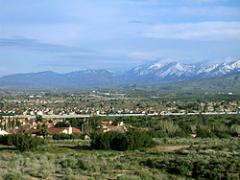
Palmdale is a city located in the center of northern Los Angeles County, California, United States.
Palmdale was the first community within the Antelope Valley to incorporate as a city on August 24, 1962; 47 years later, voters approved creating a charter city in November, 2009. Palmdale is separated from Los Angeles by the San Gabriel Mountain range. Palmdale's population was 152,750 at the 2010 census, up from 116,670 as of the 2000 census. Palmdale is the 32nd most populous city in California and ranks 158th nationally. According to the Greater Antelope Valley Economic Alliance report of 2009 the Palmdale / Lancaster, CA Urbanized Area (a US Census Bureau defined term) has a population of 483,998.
Over the last 25 years this city has consistently been ranked in the top 25 fastest growing cities in the United States (based on percentage change). As of the 2010 census, the population was 152,750, sixth largest, and fastest growing city in Los Angeles County. With 106 square miles (275 km2) of land in its incorporated boundaries, the city is the second largest city in Los Angeles County, 6th largest in California, and in the top 100 largest cities in the United States in geographic area. Palmdale is also one of the largest cities in the United States that is not currently served by either an Interstate Freeway or a U.S. Highway. Sierra Highway was at one time labeled as U.S. Highway 6 until the State of California truncated it at Bishop.
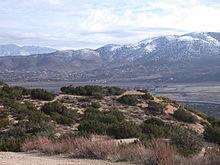
The city is known as a family-oriented community with a high quality of life. Palmdale Regional Medical Center, a first class medical facility opened in 2010, includes an emergency department, a helipad, medical office towers, and a senior housing complex. A new multimodal transportation center, serving local and commuter bus and train services, opened in 2005. A voter-initiated and approved tax has funded major park and recreation expansions, including the Palmdale Amphitheater (capacity 10,000), two new pools, other recreation buildings, satellite library and Dry Town Water Park. Downtown revitalization includes hundreds of new senior housing units, a new senior center, and expanded open space. A new 48,000 sq ft (4,500 m2). Sheriff station opened in July 2006, the largest in Los Angeles County. Two additional fire stations have been built, one on the east side and one on the west side.
While Palmdale is still a part of Los Angeles County, the urbanized centers of Palmdale and Los Angeles are separated by the San Gabriel mountain range, which is about 40 miles (64 km) wide. This range forms the southern edge of the Antelope Valley portion of the Mojave Desert. Palmdale is the second largest city in the Antelope Valley, and the fifth largest city overall in the Mojave Desert by population, outstripped only by Las Vegas, Henderson, North Las Vegas and Lancaster, California.

Palmenthal, the first European settlement within the limits of Palmdale, was established as a village on April 20, 1886 by westward Lutheran travelers from the American Midwest, mostly of German and Swiss descent. According to area folklore, the travelers had been told they would know they were close to the ocean when they saw palm trees. Never actually having seen palm trees before, they mistook the local Joshua trees for palms and so named their settlement after them. (Palmenthal is German for Palms Valley.) According to David L. Durham Joshua trees were sometimes called yucca palms at the time, which was the reason for the name. The village was officially established upon the arrival of a post office on June 17, 1888.
By the 1890s (soon after the last of the indigenous antelopes, which the valley was named after, had died) farming families continued to migrate to Palmenthal and nearby Harold to grow grain and fruit. However, most of these settlers were unfamiliar with farming in a desert climate, so when the drought years occurred, most abandoned their settlement. By 1899, only one family was left in the original village. The rest of the settlers, including the post office, moved closer to the Southern Pacific railroad tracks. This new community was renamed Palmdale and was located where the present day civic center is. A railroad station was built along the tracks there. This railroad was operated by Southern Pacific and traveled between Los Angeles and San Francisco. The Wells Fargo stagecoach line that ran between San Francisco and New Orleans stopped there as well. The only remaining pieces of evidence of the original settlements of Palmenthal and Harold are the old Palmdale Pioneer cemetery located on the northeast corner of Avenue S and 20th Street East, recently acquired and restored by the city as part of a future historical park, and the old schoolhouse now relocated to McAdam Park.
As the population of Palmdale began to increase after relocation, water became scarce, until November 5, 1913 when the California ae Los Angeles Aqueduct system was completed finally by William Mulholland, bringing water from the Owens Valley into Los Angeles County. During this period, crops of apples, pears and alfalfa became plentiful.
In 1915, Palmdale aos first newspaper, the Palmdale Post, was published. Today it is called the Antelope Valley Press.
In 1921, the first major link between Palmdale and Los Angeles was completed, Mint Canyon/Lancaster Road, later designated U.S. Route 6. Completion of this road caused the local agricultural industry to flourish and was the first major step towards defining the metropolis that exists today. Presently this road is known as Sierra Highway.
In 1924, the Littlerock Dam and the Harold Reservoir, present day Lake Palmdale, were constructed to assist the agricultural industry and have enough water to serve the growing communities.
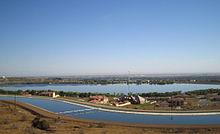
Agriculture continued to be the foremost industry for Palmdale and its northern neighbor Lancaster until the outbreak of World War II. In 1933, the United States government established Muroc Air Base (from an original founder name, Effie Corum, spelled backwards) six miles (10 km) north of Lancaster in Kern County, now known as Edwards Air Force Base. They also bought Palmdale Airport in 1952 and established an aerospace development and testing facility called United States Air Force Plant 42. One year later, in 1953, Lockheed established a facility at the airport. After this point in time, the aerospace industry took over as the primary local source of employment, where it has remained ever since. Today the city is even referred to as the auAerospace Capital of America au because of its rich heritage in being the home of many of the aircraft used in the United States military.
In 1957, Palmdale aos first high school, Palmdale High School, was established, making it easier for youths to not have to travel to Antelope Valley High School in nearby Lancaster.
In August 1962, the township of Palmdale officially became the city of Palmdale with the incorporation of 2 square miles (5 km2) of land around the present day civic center.
In 1964, the Antelope Valley Freeway, or State Highway 14, was completed as a link between Palmdale and Los Angeles. The freeway at this time ran all the way to present day Technology Drive. It was at this time that talk about the future Palmdale Intercontinental Airport was seen as the way of the future. By 1965 the new city had annexed an additional 20 square miles (52 km2) of land and industry was thriving. Talk of the future commercial airport had many investors buying up large quantities of land.
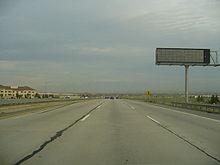
In 1970, the city of Los Angeles went forward with buying 17,750 acres (71.8 km2) of land east of the city for its proposed intercontinental commercial airport. However, the United States Air Force desired to put a hold on the construction of this new facility until the existing airport reached its commercial capacity. So under a joint use agreement with the military, the Los Angeles Department of Airports, now called Los Angeles World Airports, built a 9,000 square foot (800 m ²) terminal on leased land that opened in 1971, creating present day LA/Palmdale Regional Airport which the City of Palmdale has taken control of in an effort to establish reliable air service in the region.
By 1974, the Antelope Valley Freeway construction ended at the southern border of Mojave in Kern County. In 1977, Palmdale built its first municipal building, the Palmdale City Library. This was the same year that its northern neighbor Lancaster incorporated itself into a city. Since the 1920s, Lancaster had been the much larger and principal community of the Antelope Valley, as well as the rest of California's Mojave Desert.
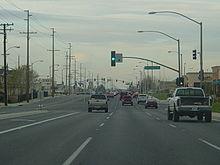
The 1980s and 1990s were the decades that really started to define the two Antelope Valley cities. Affordable housing in the area caused a dramatic spike in the population. The city became a bedroom community for those employed in Los Angeles. Palmdale's population continued to approach Lancaster's. Throughout the eighties and even the nineties, Palmdale was the fastest growing city in California and second fastest growing city in the nation. In 1980, Palmdale's population was 12,227.
By 1990, it had soared to 68,842. During that same year the Antelope Valley Mall opened at Avenue P (present day Rancho Vista Blvd.) and 10th Street West, presently the busiest intersection in the entire Mojave Desert. In 1991, the Palmdale Auto Center complex opened. Throughout the 1990s and early first decade of the 21st century, central Palmdale has become the retail and commercial center of the California High Desert. In 2000, the city's population was 116,670. With over 150,000 residents today, the City Planning Commission continues to attempt a form of managed growth in the early part of 21st century. The recent subprime mortgage crisis has affected the city with a tremendous number of foreclosures, much like other cities in California. However, even with the high number of foreclosures, the city remains the fastest growing city in Los Angeles County, and the fastest growing large city in the State of California.
Palmdale has three separate elementary school districts and one high school district:
Palmdale is a Charter City governed under the council / manager form of local government. The mayor is elected every two years for a two-year term. Also every two years, two of the four council members are elected to serve four-year terms. Palmdale does not have term limits for council and mayor. The current mayor, James C. Ledford, is serving his tenth term in office. The City Council appoints the City Manager and City Attorney.
The city also has an appointed Planning Commission divided into four separate districts. The Planning Commission was organized to help with the planning, zoning, and development of various city areas in different districts and to give the residents of those particular districts a greater voice in local land use decisions. There is also an appointed Board of Library Trustees, and Youth Council.
On November 3, 2009, local residents voted in favor of a measure to change Palmdale's general law city status to that of a Charter City. This allowed Palmdale to draft a city charter and constitution, enabling it to make more decisions at the local level without interference or rules from the state government.
The city provides a number of municipal services, including a Planning Department, Economic Development Department and Redevelopment Agency, Building and Safety Department, Public Works Department, Parks and Recreation Department, and Library Department. The city also operates the Palmdale Transportation Center which serves as the hub for public transit services including Metrolink trains, Antelope Valley Transit Authority, Amtrak California's Thruway Motorcoach and Greyhound. Palmdale was selected as a stop for the California High Speed Rail System, currently undergoing environmental review, that will link Northern and Southern California. City officials have formed the Palmdale Airport Authority, as they pursue regional air service from a joint use facility at USAF Plant 42.
Recreation and cultural services include the Palmdale City Library, Legacy Commons, Larry Chimbole Cultural Center, Palmdale Playhouse and Art Gallery, Dry Town Water Park, Palmdale Amphitheater, Best of the West Softball Complex, Hammack Activity Center, Palmdale Oasis Park Recreation Center, Marie Kerr Park Recreation Center, Joe Davies Heritage Airpark at Palmdale Plant 42, and four swimming pools.
The city is policed by the Los Angeles County Sheriff's Department under a formal contract with the County of Los Angeles and has its municipal judicial system intertwined with the Los Angeles County Superior Court.
The Los Angeles County Sheriff's Department (LASD) operates the Palmdale Station in Palmdale. Palmdale has the largest Sheriff's Station in Los Angeles County. Palmdale's innovative Partners Against Crime (PAC) Program, a cooperative effort between law enforcement, landlords and community members, has successfully focused on quality of life issues and crime suppression, reducing the crime rate annually. Recently, the Partners for a Better Palmdale program was initiated by the City Council, to further engage residents, schools, community groups and law enforcement in improving community quality of life. The city pioneered the use of municipal Community Service Officers for low level incidents to free up Deputies for higher priority matters, and employ high-tech tools, such as Automated License Plate Recognition Systems on patrol cars, to increase officer productivity.
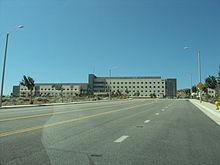
The city is served by the Los Angeles County Fire Department for its fire and paramedic services through the Consolidated Fire Protection District. Palmdale downtown Station #37 is one of the busiest fire stations in the United States. Two new fire stations went into service in late 2008 on the east and west sides of Palmdale.
Utility services within the city are provided by several public and private agencies. Water service is primarily provided by Palmdale Water District (separate public agency) and Los Angeles County Waterworks (part of the County Public Works); sewer service is provided by the County Sanitation Districts of Los Angeles County (separate public agency); electrical service is provided by Southern California Edison; natural gas service is provided by Southern California Gas; cable television service is provided by Time Warner Cable; telephone service is provided by AT&T and Verizon; refuse pickup and disposal service is provided by Waste Management, Inc of the Antelope Valley under a franchise agreement with the city. The city is actively pursuing state licensing towards construction of its own hybrid natural gas and solar steam turbine power plant.
The Los Angeles County Department of Health Services operates the Antelope Valley Health Center in Lancaster, serving Palmdale.
In the state legislature Palmdale is located in the 17th Senate District, represented by Republican Sharon Runner, and in the 36th Assembly District, represented by Republican Steve Knight. Federally, Palmdale is located in California's 25th congressional district, which has a Cook PVI of R +7 and is represented by Republican Buck McKeon.
According to the latest U.S. Census report released in September 2009, Palmdale has the longest average commute time in the United States at 41.5 minutes. This commute time exceeds that of even New York City.
The Antelope Valley Freeway (SR 14) is the major North-South highway connecting Palmdale to Los Angeles and Mojave.
State Route 138 (SR 138) is the major east-west highway connecting Palmdale to the Inland Empire and Frazier Park.
State Route 18 (SR 18) heads eastward out of the Antelope Valley connecting it to Victorville and via I-15 the Barstow area. This road is commonly used as a route to Las Vegas, Nevada.
Future Highways:
Cash-strapped Caltrans only recently began upgrades to SR 138 (nicknamed "Blood Alley" due to the high rate of accidents that occur). CalTrans has had plans on the table for several years for SR 138 and SR 18 to create an east/west freeway between Palmdale and I-15. Due to State funding constraints, this expressway will probably not be completed until near 2020 as the planning, design and construction process can take as many as 10 ae15 years. There has been discussion of creating the High Desert Corridor tollway in its place. There is also a long-lost plan to continue the freeway from Palmdale along the southern foothills of the Antelope Valley to I-5 in Gorman.
State Route 48 (SR 48) is a planned east / west freeway connecting from the Antelope Valley Freeway (SR 14) at Avenue D, the current segment terminus for the western SR 138 branch, to Interstate 5 in Gorman. This freeway is planned to come after SR 138 has its new southern realignment through Palmdale completed, and will follow the existing SR 138 right of way.
State Route 122 (SR 122) is a planned north / south freeway from eastern Palmdale, passing east of Edwards Air Force Base to SR 58 near California City.
State Route 249 (SR 249) is a planned north / south freeway from southern Palmdale to I-210 in La Canada Flintridge, near Pasadena.
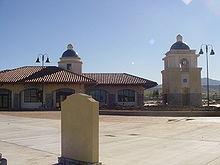
The Palmdale Transportation Center, completed in March 2005, is the central mass transit center for the Antelope Valley. It serves as the transit hub for the Antelope Valley Transit Authority, the city's public bus system, as well as an Amtrak, Greyhound Bus, and commuter rail Metrolink station. The station is also designated a stop on the proposed California High Speed Rail System and the proposed Orangeline Maglev rail from Irvine.
The LA/Palmdale Regional Airport/Air Force Plant 42 (PMD) has two runways, each over 2.25 miles (3.62 km) in length, although there is currently no commercial airline service at the airport. PMD's commercial terminal is owned and operated by Los Angeles World Airports (LAWA), a municipal department of the City of Los Angeles, on leased land from the U.S. Air Force. Airline service has been sporadic since commercial flights were first offered in 1971. Most recently, United Express/SkyWest Airlines flew between PMD and San Francisco from June 7, 2007, to December 6, 2008. The city of Palmdale formed the Palmdale Airport Authority to move forward to control the facilities and the lease with the USAF, to better develop regional air service in the High Desert.
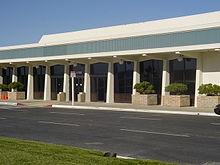
LAWA also owns 17,500 acres (71 km2) of land adjacent to the existing airport. The land was acquired between 1970 and 1983 to be developed into "Palmdale Intercontinental Airport", intended to surpass the air traffic of LAX. The land remains undeveloped. LAWA is currently developing a Master Plan for Palmdale that will guide airport land use and development decisions through 2030.
The FAA's Los Angeles Air Route Traffic Control Center is located adjacent to the airport.
NASA has consolidated its research, environmental and training aircraft, support services and facilities at the Dryden Aircraft Operations Facility in Palmdale. From the over-sized runway and the massive hangar located at Air Force Plant 42 Site 9, NASA conducts worldwide environmental research with its ER-2 (a U-2 variant) and cutting edge deep space imaging with the 747-based SOFIA infrared telescope.
Palmdale is developing a network of bike lanes and bike paths throughout its boundaries. The backbone of the system is a new, grade separated Class A bike path on Avenue S, between 5th Street East and 25th St East, that was included as part of a $20 million highway improvement project, and a similar path on Sierra Highway, that runs from Technology Drive (Avenue P-8) north to meet with the Lancaster segment up to Avenue J. There are also bike lanes on some local streets, leading to parks and schools, as well.
Cycling in certain areas of Palmdale carries an increased risk due to higher speed limits for vehicles and also due to the presence of large vehicles.
Palmdale is also a location frequently used in staging of the Tour of California.
The street system in the Antelope Valley is set out in a grid. Unless otherwise named or curved around due to terrain, east-west roads are called avenues and north-south roads are called streets. The city is essentially on a perfect grid, and the traffic signals are coordinated by a central processing facility at the Civic Center.
East-west avenues are lettered mile-by-mile from north to south, starting with Avenue A on the Los Angeles-Kern County line. One mile south of Avenue A is Avenue B, and so on. Smaller roads between major avenues carry suffixes "-1" (nearest to the lettered avenue) through "-15" (nearest to the next lettered avenue). Some "-8" avenues can be major thoroughfares, for example, Avenue R-8 is halfway between Avenue R and Avenue S.
North-south streets are numbered with an "east" or "west" suffix with respect to their distances from Division Street. The number increases by 10 for each mile, so a mile east and west of Division Street lie "10th Street East" and "10th Street West" respectively. Some streets like 5th or 15th can also be major thoroughfares.
House addresses on east-west "avenues" are numbered according to the "streets". For example, "2001 East Palmdale Boulevard" is just east of 20th Street East, and "6066 West Avenue M-2" is just west of 60th Street West on Avenue M-2, which is 2/16 of a mile south of Avenue M.
On north-south streets, numbers are counted from Downtown Los Angeles (thus increase from south to north), and while in the Antelope Valley, the difference is 800 per mile. For example, Palmdale Boulevard (geographically "Avenue Q-8") is 38400, Avenue Q is 38800, Avenue P is 39600, and so on. "37200 25th Street East" would be at the corner of Avenue S.
In accordance with Los Angeles County standards, odd numbers are on west and north sides of the road, and even numbers are on east and south sides of the road.
Avenue M is the general border of the connected population between Palmdale and Lancaster. Avenue L is actually the longer border between the two cities, east of Challenger Way, but is not as heavily populated. Avenue M has recently been named Columbia Way out of respect for the astronauts on board the Space Shuttle Columbia that disintegrated on re-entry in 2003. 10th Street East north of Columbia Way was renamed Challenger Way in 1987, in honor of those lost in the Challenger Disaster. (All of the shuttles were built in Palmdale.)
Palmdale is located in the High Desert, where the summers are very hot and dry, and winters are cool and windy. Palmdale has over 300 days of sunshine per year. The same weather pattern that brings the marine layer stratus and afternoon sea breeze to the Los Angeles Basin brings gusty winds to Palmdale, especially near the foothills on the south side. Except during Santa Ana (northeast) wind events (usually fall and winter), gusty southwest winds blow over Palmdale almost every afternoon and evening all year round. The wind is so reliable that wind turbines are used to generate electricity.
Winter: Relatively chilly, wet and windy. Temperatures have gone into the single-digits at times. The wind chill factor can be below zero. This is Palmdale's rainy season and is prone to flash flooding during this time. On occasion, it will snow, sometimes with several inches of accumulation. Average day time highs are in the upper 50s to low 60s while being in the low to mid 30s overnight.
Spring: Moderate temperatures. Still occasionally wet. Very windy. Transitional period from winter to summer temperatures is very short. Average daytime highs are in the upper 70s to low 80s while being in the upper 40s to low 50s overnight.
Summer: Very hot, dry heat with little or no precipitation. Temperatures frequently soar into triple-digits. However, the high desert where Palmdale is located allows for the temperatures to cool down somewhat at night, unlike the low desert cities of Palm Springs and Blythe. Average day time highs are in the upper 90s while dropping into the mid to upper 70s after midnight. Local electrical bills spike during this period with air-conditioning units running day and night, until early October. Despite the hot temperature, it is very common to experience "summer storms" in which temperatures are consistent but there is heavy rain and thunderstorms.
Fall: Moderate temperatures with little or no precipitation. Transitional period from summer to winter temperatures is very short. As a result, the deciduous trees in Palmdale will lose their leaves very rapidly, seemingly overnight, with a short color change. Average day time highs are in the upper 70s and low 80s while dropping into the mid 40s to mid 50s overnight.
The 2010 United States Census reported that Palmdale had a population of 152,750. The population density was 1,438.1 people per square mile (555.3/km2). The racial makeup of Palmdale was 74,901 (49.0%) White, 22,677 (14.8%) African American, 1,316 (0.9%) Native American, 6,548 (4.3%) Asian (2.2% Filipino, 0.4% Indian, 0.4% Korean, 0.3% Chinese, 0.3% Vietnamese, 0.2% Japanese), 335 (0.2%) Pacific Islander, 38,773 (25.4%) from other races, and 8,200 (5.4%) from two or more races. Hispanic or Latino of any race were 83,097 persons (54.4%). 38.1% of Palmdale is Mexican, 6.2% Salvadoran, 2.4% Guatemalan, 0.7% Puerto Rican, 0.5% Cuban, 0.4% Honduran, 0.4% Nicaraguan, 0.4% Peruvian, 0.3% Ecuadorian, 0.3% Colombian, and 0.2% Argentinean.
The Census reported that 152,551 people (99.9% of the population) lived in households, 158 (0.1%) lived in non-institutionalized group quarters, and 41 (0%) were institutionalized.
There were 42,952 households, out of which 23,345 (54.4%) had children under the age of 18 living in them, 24,199 (56.3%) were opposite-sex married couples living together, 7,821 (18.2%) had a female householder with no husband present, 3,318 (7.7%) had a male householder with no wife present. There were 2,998 (7.0%) unmarried opposite-sex partnerships, and 316 (0.7%) same-sex married couples or partnerships. 5,828 households (13.6%) were made up of individuals and 1,880 (4.4%) had someone living alone who was 65 years of age or older. The average household size was 3.55. There were 35,338 families (82.3% of all households); the average family size was 3.87.
The population was spread out with 50,514 people (33.1%) under the age of 18, 17,089 people (11.2%) aged 18 to 24, 40,077 people (26.2%) aged 25 to 44, 34,963 people (22.9%) aged 45 to 64, and 10,107 people (6.6%) who were 65 years of age or older. The median age was 29.7 years. For every 100 females there were 95.3 males. For every 100 females age 18 and over, there were 91.3 males.
There were 46,544 housing units at an average density of 438.2 per square mile (169.2/km2), of which 29,167 (67.9%) were owner-occupied, and 13,785 (32.1%) were occupied by renters. The homeowner vacancy rate was 3.2%; the rental vacancy rate was 9.4%. 102,444 people (67.1% of the population) lived in owner-occupied housing units and 50,107 people (32.8%) lived in rental housing units.
Downtown Palmdale is located at 34 °34 a²46 a³N 118 °07 a²00 a³W / 34.57944 °N 118.1166667 °W / 34.57944; -118.1166667, at an elevation of 2,655 feet (809 m) above sea level.
According to the United States Census Bureau the city has a total area of 106.2 square miles (275 km2), of which, 106.0 square miles (275 km2) of it is land and 0.3 square miles (0.78 km2) of it is water (including man-made Lake Palmdale, the most visible and scenic part of the municipal water supply system) . The total area is 0.24% water.
The city lies in close proximity to the San Andreas Fault, making it, like many other regions of California, prone to strong earthquakes. This faultline cuts across the Antelope Valley Freeway just north of the Avenue S off-ramp; running westward along the old Butterfield Stage Line (now Elizabeth Lake Road) into Leona Valley.
The Palmdale vicinity currently has a total of ten ZIP codes:
The most important industry for Palmdale is the aerospace industry. However, in recent times, other manufacturing companies have relocated to Palmdale seeking more affordable land, proximity to Palmdale Airport, and special tax breaks.
The special tax breaks granted for companies that relocate to Palmdale is due to the city having the Antelope Valley Enterprise Zone and the Palmdale Federal Foreign Trade Zone. These are special zoning areas within the city that are given various state and federal tax breaks and municipal grant incentives to relocate their business there. These zones were put in effect to help Palmdale and nearby Lancaster draw more jobs to the area so that they would be less dependent on the Los Angeles Basin area for employment, thus relieving pollution and traffic congestion and stabilizing the local economy on several industries. The aerospace industry is known for having aufeast or famine au seasons.
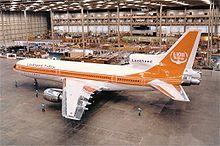
Palmdale refers to itself with the nickname the "aerospace capital of the United States", and has been the site of research, development, final assembly, flight testing and/or servicing/modifications of the Space Shuttle, B-1 Lancer, X-15, B-2 Spirit, F-117 Nighthawk, F-35 Lightning II, SR-71 Blackbird, Lockheed L-1011 Tristar, and many other aircraft that have been used in the United States Air Force, NASA and air forces and airlines around the world. USAF Plant 42, where the aforementioned aerospace projects occurred / occur is home to major operations of the following aerospace companies: Boeing, Lockheed Martin and its famed Skunk Works, and Northrop Grumman. The Los Angeles World Airports owns the former Boeing hangar (formerly North American Rockwell) at Plant 42 near LA/Palmdale Regional Airport which is one of the largest buildings in the world. The hangar was used for the set of the 2004 film The Terminal, which featured an enormous replica of a JFK International Airport terminal. NASA's SOFIA program relocated its operation to this hangar at Site 9 from Edwards Air Force Base.
A number of world class corporations and manufacturing firms have made Palmdale home, helping to diversify the local economy. Delta Scientific, a world leader in high strength vehicle barrier systems, supplying protection for many federal, state and local buildings, and a prime supplier to the military and US State Department for embassies and other installations worldwide, and US Pole, a major manufacturer of street lighting poles, are major anchor tenants in the Fairway Business Park. The Palmdale Trade and Commerce Center is home to many other major manufacturing, industrial, corporate offices and other employers, as well as home to the Palmdale Auto Mall. A number of medical and related support offices are coming on-line to meet the needs of the new Palmdale Regional Medical Center. On July 8, 2009 Quallion LLC, which manufactures lithium ion cells and battery packs, announced plans to build a battery manufacturing plant in Palmdale if it won a government grant being offered by the U.S. Department of Energy.
The Antelope Valley Mall is the preeminent retail shopping destination in the region, with a wide variety of dining choices on its restaurant row.
Beginning in the 1960s, Palmdale was home to Don Babb's The Model A Ford Company, which became Classic Manufacturing and Supply, builder of exact reproduction and custom steel bodies and parts for hot rods and customs.
Antelope Valley New Press

Word Count: 5901







